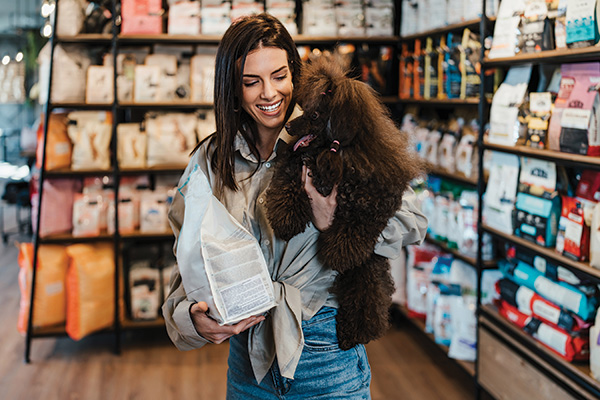This article was published in the May 2024 issue of Pet Food Processing. Read it and other articles from this issue in our May digital edition.
The US pet food industry remains strong with growth projections of $126.66 billion in 2024, but changing demographics and consumer behaviors are creating ripples across the industry. Economic uncertainty is forcing some to consider meaningful changes, including the 97% of pet owners who consider pets a part of the family. These are potentially big impacts, especially when you consider in 2023, 62% of Americans owned a pet and 35% owned more than one pet, according to the Pew Research Center, Washington, DC.
While pet owners who belong to higher tax brackets remain less susceptible to economic uncertainty, more seasoned pet owners are seeking out the best value for their money with inflationary pressures complicating what once might have been a straightforward purchasing decision. This means pet food processors can no longer just rely on affluent households. They also need to court lower-income households who are looking for lower prices, special offers and sales, with many feeling pet products are becoming too expensive.

According to the American Pet Products Association’s 2024 National Pet Owner Survey, 56% of Gen Zers learn about pet care products via TikTok, compared to 32% of Millennials.
|However, when talking about a shift to lower-cost pet care products and services, it’s important to note that pet owners may want to save money, but they don’t want to sacrifice quality to do so, according to Shannon Landry Brown, pet brand manager for Packaged Facts under The Freedonia Group, a division of MarketResearch.com, Cleveland.
Product quality is a prime consideration when looking for what pet products to buy. This may even find consumers cutting back in other areas in order to keep purchasing more premium food. But depending on the needs of the pet, a consumer could be both willing and forced into premium categories for their pet’s health and nutrition, said Melanie Torres, research analyst, food and pet care, Euromonitor International, London.
Younger pet owners
A recent Packaged Facts webinar, “US Pet Market Outlook 2024,” highlighted an additional consideration: the rise of younger pet owners and how to balance the desire for pet ownership with ongoing economic challenges. Around one-fourth of pet owners in the United States are Millennials (born 1981 to 1996), many of whom opt for pet ownership before having a child as a sort of test-drive before becoming parents.
The combination of returning student loan liabilities and a struggling housing market is finding many younger pet owners in a credit crunch, and it’s also impacting the species of pet chosen. For example, homeowners with a yard are more likely to have a dog. These younger generations also grew up surrounded by pessimistic outlooks on the economy and global climate, as well as the pandemic, and as a result may experience a strong sense of isolation and disconnect, according to Torres.
“Social media apps like TikTok facilitate the promotion of these intense familial bonds between pet and parent as a standard way of life,” said Melanie Torres, Euromonitor International.
“This makes these consumers more eager to seek consistent ‘guaranteed’ companionship of family through a pet,” she continued. “Additionally, social media apps like TikTok facilitate the promotion of these intense familial bonds between pet and parent as a standard way of life. These online influences intensify the sense of FOMO (fear of missing out) that younger consumers feel when they don’t connect with the same trends or lifestyles as their peers.”
These demographics find a sense of community online and are particularly trusting of social media to inform trends or perceptions of key brands, corporate responsibility and nutritional quality. The rise in omnichannel also offers opportunities to connect with prospective customers. Gen Z and Millennials are particularly keen on social media pet influencers, according to Torres. Online is being embraced by consumers searching for specific product attributes, rather than for specific brands.
“This reflects a shift from consumers relying on retailers to identify trustworthy brands,” Torres said. “Now, consumers are spending more time comparing products, and they are increasingly open to following the product rather than choosing from what a retailer offers. This is particularly true for newer pet owners who seek very specialized, new product offerings.”
Online pet food sales are seeing growth within the direct-to-consumer (DTC) space, as consumers become more willing to trust buying directly from brands. Knowing where these influencers are and who they look to influence is key to understanding how these demographics shop. These quickly moving evolutions are why traditional demographics such as gender, race, age, income and education level are no longer as effective in determining purchase behaviors.
Human-centric trends
Looking to defy the status quo, younger generations are demanding a higher level of engagement from pet food and treat processors. This includes some bleed over of human nutrition ideals, such as the fear of processed food and lengthy ingredient lists. Such heightened awareness translates into a higher level of scrutiny when it comes to the ingredients in a pet’s diet and how it’s processed.
Consumers who embrace fresh food trends are familiar with packaging in rolls, transparent plastic or pouches that closely resemble packaging for human food products. Torres cited positive associations with these packaging types as another determining factor in a decision to trade down to a more shelf-stable option. But a consumer who can no longer afford their pet’s favorite refrigerated fresh food might have difficulty swapping for canned food because of its associations with high processing.
CRB, Kansas City, Mo., is seeing a move toward lower thermal processing, or minimal processing, according to Tony Moses, CRB Fellow, product innovation. More manufacturers are planning to expand hot fill and hold compared to retort capabilities, and more plan to expand HPP (high pressure processing) and freeze drying compared to oven baking.
“The switch to minimal processing methods can have a major impact on packaging types,” he said. “For example, hot fill and hold requires bottles that can be capped or lidded, versus cans for retort. And HPP requires flexible packaging. Manufacturers will want to consider the performance of these materials in processing, as well as how consumers react to their presence on shelf.”
CRB also finds processors paying more attention to sustainability in corporate reporting. Ninety-five percent of companies have sustainability plans.

At this time, there are more Millennial pet owners than any other demographic.
|“Manufacturers believe it’s one of the top drivers for attracting and retaining customers, and it ranked as the most common driver for product innovation,” Moses said.
A Supermarket Scorecard survey from the ASPCA, found 91% of the public agree companies should address both the environment and the humane treatment of farm animals as a part of their corporate sustainability programs. Seventy-six percent of those living in urban areas report being likely to switch pet food brands if they knew they put more care into sourcing from more humane farms. That number jumps up to 88% in rural areas and 90% in suburban areas, according to Maral Cavner, senior manager of corporate policy, ASPCA Farm Animal Welfare.
“Those under 30 years of age versus those over 30 are more likely to indicate they are concerned about the welfare of animals raised for food,” Cavner continued.
“Nearly nine out of 10 (87%) of those buying pet food reported being likely to switch to another brand of pet food if they knew they put more care into where they source their animal-derived ingredients,” according to the ASPCA 2023 Pet Food Survey Memo.
Cavner cautioned pet food brands should be wary of using misleading claims that are not verified to ensure they’re offering products that meet consumers’ standards. “Humane washing” refers to food labels that overstate higher-welfare farming practices.
Choosing quality
Results from a January 2024 Packaged Facts survey show product quality is a prime consideration for 71% of pet owners when deciding what to buy, and for 50% of pet owners when deciding where to buy it. Good value is almost equally important, cited by 61% of pet owners for what to buy and 60% for where to buy it. This is compared to only 36% of pet owners citing low prices as impacting what they buy, with low prices being less important than brand names.
Even if consumers want to lean toward more economy brands, discontinuations have left limited options, leading consumers to mid-price and premium pet foods. The NIQ 2024 Consumer Outlook from NielsenIQ, Chicago, found that consumer survival tactics have shifted into long-term behaviors as rising food prices remain top of mind. Increased living costs, economic slowdown, and job insecurity or loss have created a cost-of-living crisis that sees the costs of goods rising 31% higher versus four years ago. But even in a good economy, the cost of pet ownership is high.
“A notable change is that some pet owners are trading down to lower-priced brands,” said Shannon Landry Brown, Packaged Facts.
“A notable change is that some pet owners are trading down to lower-priced brands, a category with traditionally very sticky spending because of the strong relationship pet parents rightfully make between pet food and pet health,” Landry Brown said.
Packaged Facts’ survey results show that among pet owners who had switched pet foods in the past year, 32% of dog owners and 28% of cat owners had switched to a lower-priced brand.
Private-label projections
Over the past couple of years, there’s also been a slow rise in the share of pet food purchasers using private-label foods, according to MRI-Simmons usage data. Changing pet owner attitudes about private-label foods is encouraging this growth. Packaged Facts’ survey results show 37% of dog and cat owners agree private-label pet foods provide the same or better quality compared to national brand pet foods.
Yet adoption of private label is typically much lower in North America than its European counterparts, according to Lynn Dornblaser, director, innovation and insight, Mintel, Chicago, in a presentation at the American Feed Industry Association’s (AFIA) Purchasing and Ingredient Suppliers Conference in March. This presents an opportunity for growth in private labels and more options for emphasis on private labels by retailers. With many pet owners being open to changing a pet’s diet to improve health, there are numerous opportunities to address concerns for specific breeds and activity levels with the possibility of pet DNA testing in the future to tailor pet nutrition, Dornblaser said.
“Seeking the best value for their dollar, consumers can find the switch up to premium more justifiable, even if it is to a premium private-label option,” Torres said. “Supplements are also continuing to gain traction as pet owners seek to improve overall health, drawn in by rising claims of age-reversing or life-extending products. In the eyes of many, an expensive supplement is only a small price to pay in hope for more years with a beloved family pet.”
Whether a purchase is about the economy, premiumization, health, or all of the above, it’s also likely to be strongly motivated by an emotional connection to one’s animal. That means processors must keep a close eye on the more emotional, human side of things and expect that purchase decisions may not always be driven by logic or demographics.
Keep up with the latest pet food trends on our Trends page.



